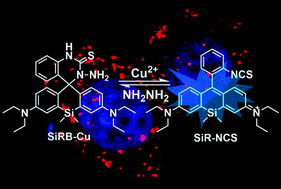A six-membered-ring incorporated Si-rhodamine for imaging of copper(ii) in lysosomes†
Abstract
The regulation of copper homeostasis in lysosomes of living cells is closely related to various physiological and pathological processes. Thus, it is of urgent need to develop a fluorescent probe for selectively and sensitively monitoring the location and concentration of lysosomal Cu2+. Herein, a six-membered ring, thiosemicarbazide, was incorporated into a Si-rhodamine (SiR) scaffold for the first time, affording a SiR-based fluorescent probe SiRB-Cu. Through the effective Cu2+-triggered ring-opening process, the probe exhibits fast NIR chromogenic and fluorogenic responses to Cu2+ within 2 min as the result of formation of a highly fluorescent product SiR-NCS. Compared with a five-membered ring, the expanded ring retains great tolerance to H+, ensuring the superior sensitivity with a detection limit as low as 7.7 nM and 200-fold enhancement of relative fluorescence in the presence of 1.0 equiv. of Cu2+ in pH = 5.0 solution, the physiological pH of lysosome. Moreover, the thiosemicarbazide moiety acts not only as the chelating and reactive site, but also as an efficient lysosome-targeting group, leading to the proactive accumulation of the probe into lysosomes. Taking advantage of these distinct properties, SiRB-Cu provides a functional probe suitable for imaging exogenous and endogenous lysosomal Cu2+ with high imaging contrast and fidelity.


 Please wait while we load your content...
Please wait while we load your content...